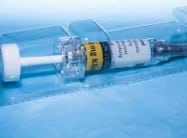Before delving fully into the meaning of the term heparin, it is necessary to know, first of all, its etymological origin. In this case, we have to establish that it derives from English, specifically from "heparin" which, in turn, is the result of the sum of two lexical components from Greek:
-The noun "hepar", which can be translated as "liver".
-The suffix «-ina», which is used to form names of substances.
Heparin is a polysaccharide that acts as an anticoagulant , preventing thrombi from appearing in blood vessels.
 It should be remembered that polysaccharides are carbohydrates (also called carbohydrates or carbohydrates ) composed of an extensive chain of monosaccharides. A monosaccharide, in turn, is a sugar whose decomposition into a simpler sugar is not possible through hydrolysis .
It should be remembered that polysaccharides are carbohydrates (also called carbohydrates or carbohydrates ) composed of an extensive chain of monosaccharides. A monosaccharide, in turn, is a sugar whose decomposition into a simpler sugar is not possible through hydrolysis .
Returning to the idea of heparin, it is a molecule formed by a chain of sugars whose main characteristic is its high sulfation . This polysaccharide has a sequence of five sugars that interact with proteins that are responsible for blood clotting.
Since it is synthesized by the body, it is considered an endogenous substance , although its biological function is still unknown. However, it can also be supplied exogenously as an anticoagulant: in this setting, heparin is injected into the blood to prevent clots or thrombi from forming.
Heparin is usually used preventively in the context of surgical interventions, during dialysis processes or after trauma . In these situations, the risk of venous thromboembolism increases, so heparin is injected to prevent the clot or, if it has already formed, to prevent it from continuing to grow.
It must be established that the discovery of heparin is attributed to the work carried out in 1918 in the United States by the pediatrician Emmett Holt (1855 - 1924) and the physiologist William Henry Howell (1860 - 1945). Of course, it must be recognized that the first steps to reach it were taken in 1916 by a medical student named Jay McLean (1890 - 1957), who was supervised at all times by Howell.
Another interesting fact about this is that the first time it was used on a person was in 1937, specifically in April and after having been tested on dogs.
Due to its benefits, heparin is often considered an essential medicine that saves millions of lives each year. While unfractionated heparin (that is, the whole molecule) requires medical monitoring, so-called low molecular weight heparin can be injected by the patient without professional monitoring.
It is also important to know that concomitant heparin has an immediate anticoagulant effect, while other anticoagulants, such as oral ones, achieve a complete effect within a maximum period of 48 to 72 hours from when they are used.
Another interesting fact is that the heparin that the patient can inject himself is usually injected in the area of the abdomen between the hips.
